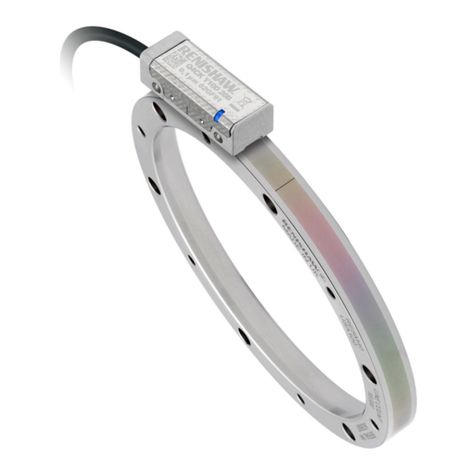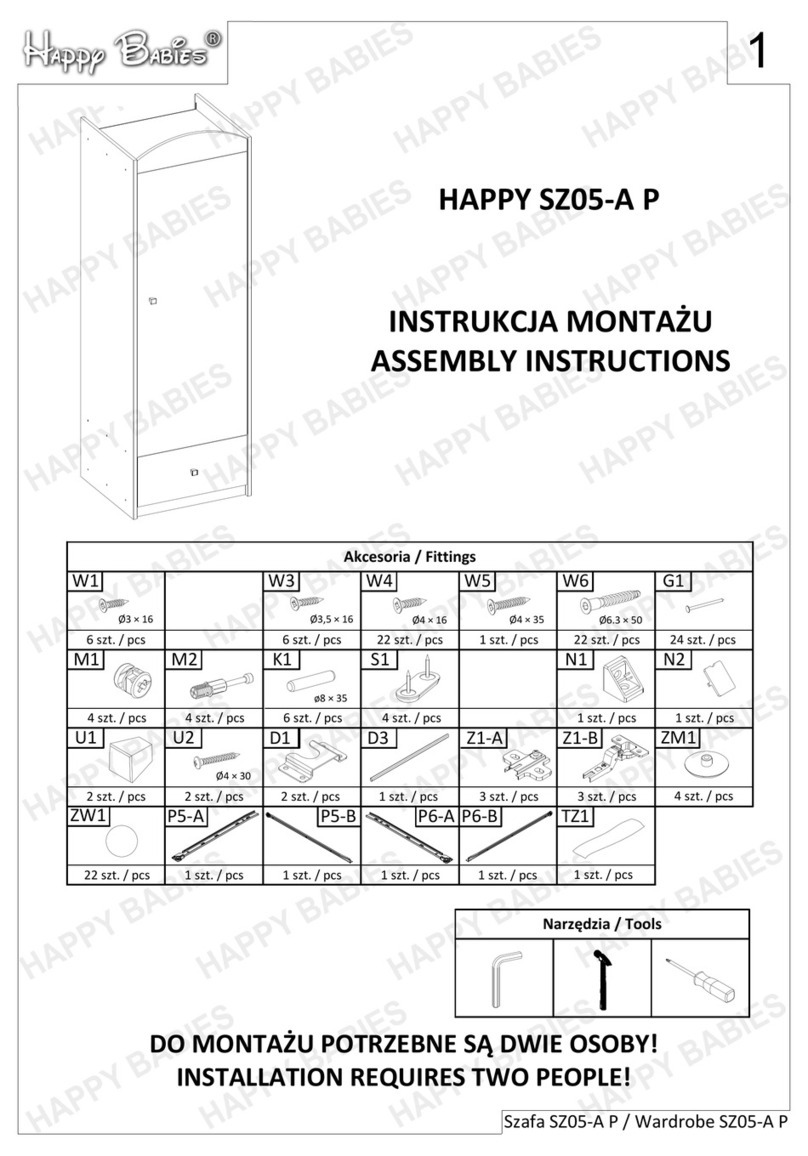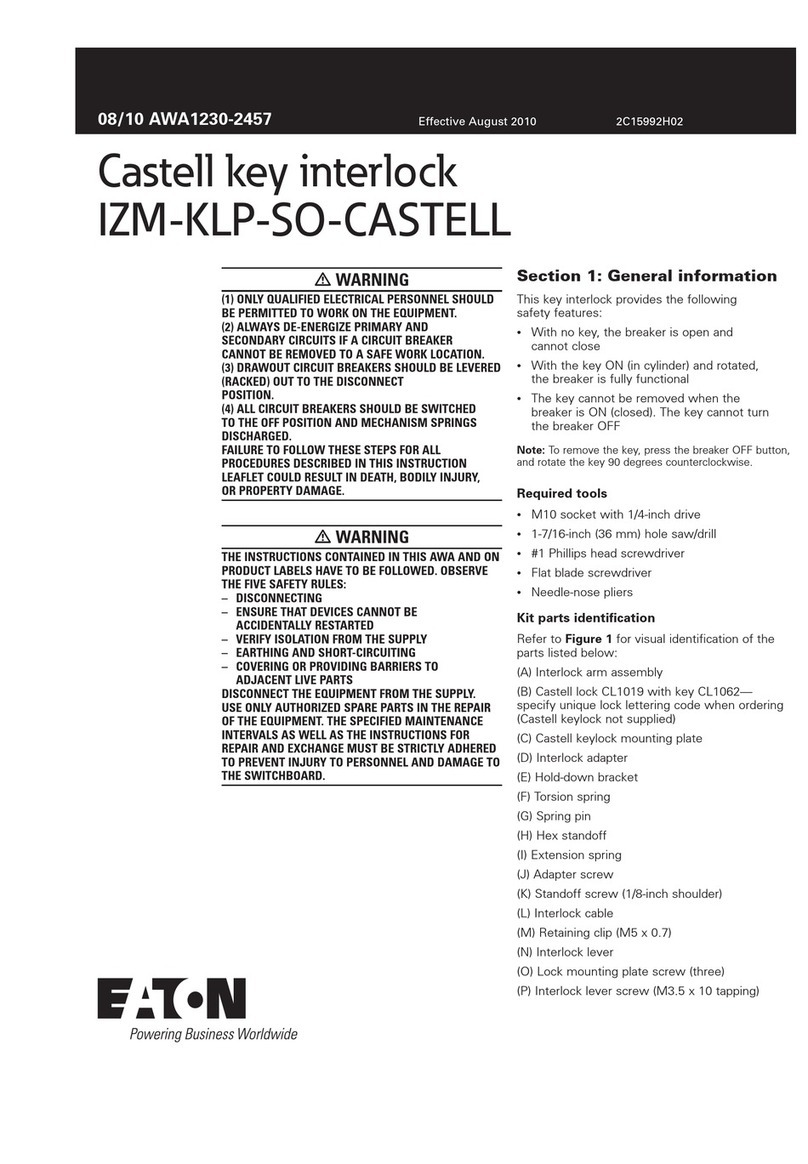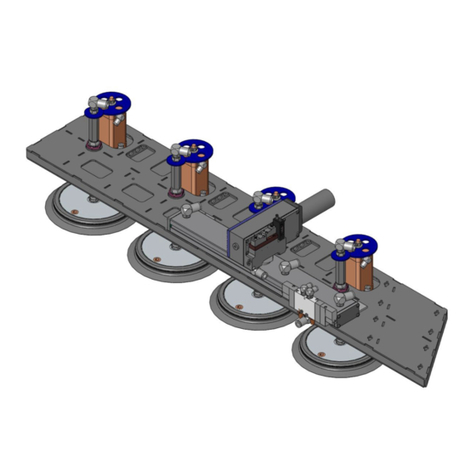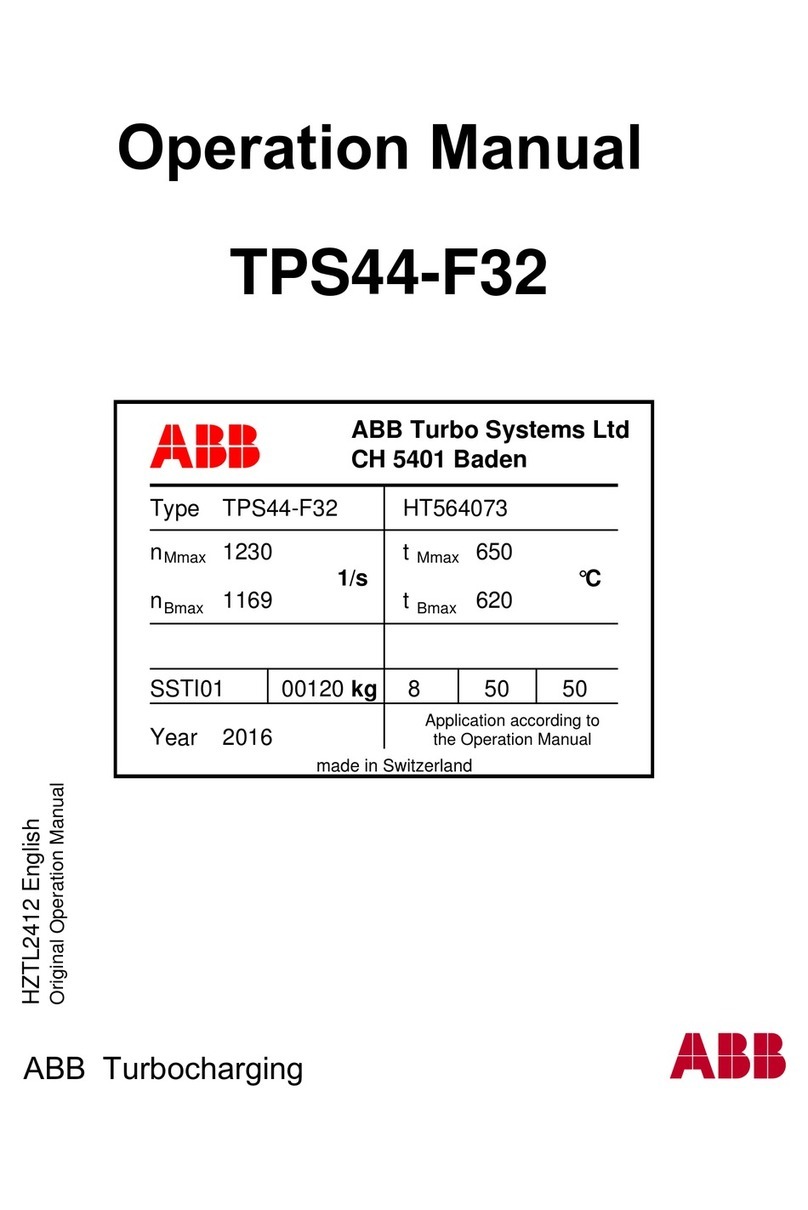Garnet SeeLevel ProSeries II 810-PS2 User manual

Page 1
810-PS2 Manual
MODEL 810-PS2 MANUAL
IMPORTANT OPERATOR INFORMATION
DATE INSTALLED:_______________________________________________________________________________
UNIT NUMBER:_________________________________________________________________________________
COMPARTMENT: _______________________________________________________________________________
DISPLAY CALIBRATION UNITS (e.g. inches, gallons): ___________________________________________
MINIMUM TANK READOUT: ___________________________________________________________________
MAXIMUM TANK READOUT: ___________________________________________________________________
ALARM #1 POINT (IF APPLICABLE): ____________________________________________________________
ALARM #2 POINT (IF APPLICABLE): ____________________________________________________________
ALARM #3 POINT (IF APPLICABLE): ____________________________________________________________
ALARM #4 POINT (IF APPLICABLE): ____________________________________________________________
AUTOMATIC ALARM: WARNING LEVEL: ____________________________________________________
EMPTY LEVEL: ________________________________________________________
PROSERIES II
TM
S
EELEVEL
Tank Truck Level Gauge
USA
Garnet US Inc.
5360 Old Granbury Road
Granbury, TX 76049
CANADA
Garnet Instruments
286 Kaska Road
Sherwood Park, AB T8A 4G7
garnetinstruments.com
1-800-617-7384

Page 2 810-PS2 Manual
Table of Contents
CHAPTER 1 - OVERVIEW.............................................................................................3
CHAPTER 2 - NEW FEATURES OF THE 810-PS2.................................................4
CHAPTER 3 - GAUGE DESCRIPTION.......................................................................6
CHAPTER 4 - UNIQUE FEATURES ............................................................................8
CHAPTER 5 - SENDER BAR LIMITS OF RESISTIVITY........................................ 10
CHAPTER 6 - 810-PS2 INSTALLATION GUIDE................................................... 13
CHAPTER 7 - SETTING DISPLAY DENSITY.......................................................... 18
CHAPTER 8 - 810-PS2 PROGRAMMING INSTRUCTIONS ............................ 22
CHAPTER 9 - TROUBLESHOOTING GUIDE......................................................... 26
CHAPTER 10 - SERVICE & WARRANTY INFORMATION ............................... 29
MAIL IN WARRANTY ................................................................................................. 31
GARNET
SEELEVELPROSERIES TM
Tank Truck Level Gauge
MODEL 810-PS2
Software rev. 6.02
810-PS2 Manual_v6.5 - 05-Feb-2019

Page 3
810-PS2 Manual
Congratulations on purchasing the Garnet Instruments Model
810-PS2 ™ Gauge for Trucks. The 810-PS2
represents the latest in state of the art liquid level measurement
equipment for transport applications. The 810-PS2 is designed
for reliable, accurate level measurement of sour or sweet crude oil,
chemicals, acids, water, condensate, gasoline, or diesel fuel. The
liquid level is determined by sensing the position of a magnetic
can operate over a range of product temperatures from -40°C to
+90°C (-40°F to +194°F).
The 810-PS2 has been designed to withstand the vibration and
shock encountered in mobile applications. The components
eliminating the need for protective enclosures. The sender bar
in the tank can withstand steaming temperatures. The gauge
operates entirely on internal batteries, so 12 volt truck power is
not required (external alarms will require truck power).
The 810-PS2 can display in any units, such as inches of level or
cubic metres of volume. It has four alarm points which can be
alarm point to operate a high level warning horn or light.
The 817 Truck Gauge Programmer can be used to program the
810-PS2 to read the desired calibration units, and to set the
alarm points. They are designed to be easily operated by people
unfamiliar with electronics or computers.
CHAPTER 1 - OVERVIEW

Page 4 810-PS2 Manual
The 810-PS2 has a number of enhancements over the previous
810-PS series. It uses new technology in the display to provide
a number of new features:
1.
device which is much more secure and does not require
power to maintain the memory contents. This should result
in a much more reliable operation, with less chance of a lost
or corrupted calibration.
2. The display can be programmed with a magnet for 8 or 11
bit operation, to work with bars in either 1/3, 1/4, or 1/6 inch
mode. If a sender bar ends up in the wrong mode, then the
display will show bad light and the number of bits received.
The previous displays would either not accept bars in 11 bit
and 11 bit modes. The mode is stored in the display in the
same secure memory as the calibration.
3. The display has improved diagnostics:
a. If the wrong number of bits are received, then the display
shows “bL:xx” where xx is the number of bits actually
received.
b.
every few seconds.
c. By connecting together two end pins on the right hand
side of the programming plug (looking at the back of the
display), the display will show a basic inch calibration,
which aids in troubleshooting to determine if the sender
bar or display calibration is at fault.
d. If there is a fault during programming or if the memory is
not functioning correctly, the display shows “Err”.
e. If the memory does not have a valid value for the number
of received bits (either 8 or 11) then the display shows
“Prob”.
f.
strong light the display will show “Sun” indicating that
into the display opto then the display may show either
“Sun” or “bL:xx” depending on the exact nature of the light
getting in.
4. The optical receiver has been improved so it cannot be
overloaded with too much light from the sender bar.
CHAPTER 2 - NEW FEATURES OF THE 810-PS2

Page 5
810-PS2 Manual
5. The display is powered entirely by four “AA” penlight alkaline
cells instead of a combination of a lithium battery and AA
cells. This allows the end user to be able to fully service any
battery problems.
6.
or fails, the display can be quickly returned to service.
7. The display has a built in SpillStop transmitter, so an additional
SpillStop module is no longer required when connecting the
gauge to an 815 SpillStop controller.
8. The display has the ability to drive a remote transmitter for
applications which require the transfer of the data from the
gauge to another piece of equipment.
Software Revision 6.02
1. See Chapter 8 to determine the software revision.
2. Prior to revision 6.02, the alarm outputs would all go to an
open circuit condition if the gauge is in a failure mode such as
no light, bad light or sun.
3. Since revision 6.02, alarms 3 and 4 will go to a closed circuit
condition during a failure mode. This change has been made
so that if the gauge is being used with the 815-JBPC junction
a gauge failure.
4.
the event of a gauge failure.

Page 6 810-PS2 Manual
The 810-PS2 gauge consists of a sender bar, a donut shaped
display, which displays the level in appropriate units and operates
the alarms, SpillStop transmitter, and remote data transmitter.
activated switches are detected by the microprocessor at the top
of the bar. The microprocessor operates from a long life lithium
battery giving about 10 years of life. The level information is
used to maintain electrical isolation between the sender bar and
The display converts the level information to volume according
to the calibration programmed into it with the 817 Truck Gauge
Programmer. The calibration can be in inches, centimetres or
volumetric units such as cubic metres or barrels. The entire display
is enclosed in a cast aluminum box with a hinged cover, which is
durable enough to be mounted on the truck or trailer without any
additional protection. The hinged cover keeps the display face
clean and operates an internal switch for LED control and alarm
resetting. The tank level is shown on two displays - an LCD (Liquid
Crystal Display) which takes very little power to operate and gives
excellent daytime visibility, and an LED (Light Emitting Diode)
display which has higher power consumption but gives excellent
night time visibility. To reduce power drain the display only turns
on the LED when the cover is open and when there is not enough
light to see the LCD display. The entire display is powered by four
replaceable alkaline AA cells giving about 1½ to 2 years of life
under normal operation (assuming that the LEDs are on for about
2 hours per day).
The display contains four alarms which are programmed using the
any point in the tank. The alarm outputs are transistors which can
handle up to 1 amp of DC current at 24 volts. The transistors are
wired to complete a circuit to ground, so only one wire is needed
to connect to each alarm.
CHAPTER 3 - GAUGE DESCRIPTION

Page 7
810-PS2 Manual
WARNING: The use of alarm points is entirely at the owner’s
risk due to the nature of connecting external horns or lights,
the reliability of external horns or lights, and the requirement
for external switches to disarm them.
Alarm 4 also has an extra transistor output on the purple wire.
With this purple wire connected to a warning horn, alarm 4
functions as a self resetting high level warning alarm. Alarm 4 is
programmed as the warning point, and alarm 3 is programmed
near the tank empty point. When the product level rises in the
tank and hits the warning point, the horn will sound. Closing and
opening the lid of the display will silence the horn. When the tank
is unloaded below the empty point, the alarm is reset so that it
way the operator cannot forget to turn on the horn. The horn will
sound at the warning point even if the lid is opened and closed
prior to the product level hitting the warning point, and will sound
with the lid in either the open or closed position when the warning
point is reached.
The display has a SpillStop transmitter for direct connection to a
Garnet 815-UHP SpillStop or 815-UHP SpillStop Ultra controller.
The transmitter operates in accordance with the programmed
alarm points 1, 2, and 3. This provides the user with automated
horn warnings and automated control of PTO loading to prevent
Installation of the gauge consists of cutting a hole in the top of
the tank and welding in a 1 inch coupler, and welding an anchor
assembly to the bottom of the tank. The sender bar is cut to
length, the end is sealed, and it is inserted from the top of the tank
is mounted at a convenient point on the truck frame or panel,
and 1/4” air brake hose is connected from the sender head to
at each end, and the gauge is programmed. Fastening on the
covers for the head and display completes the installation. The

Page 8 810-PS2 Manual
The 810-PS2 gauge has been designed for maximum ease of
installation and servicing, and for the best operational features.
The anchor at the bottom of the tank provides a shock mount for
no tank entry is required for sender bar replacement. If the new
sender bar is cut to the same length as the old, no re-calibration
is required.
good esthetic appearance, and high durability due to the “give”
in the plastic. The light weight of the polyethylene allows the
density products.
potting material to enhance reliability. The use of a digital rather
than analog sensing technique lowers power consumption to
permit battery operation, and ensures high accuracy with no drift
simply cut to length with a hacksaw, and the cut end sealed with a
cap to prevent moisture or product contamination. This way only
the maximum height is less than 5 inches above the top of the
tank so that it will not protrude above the spillway.
display can be disconnected at both ends. There is approximately
10 times as much light as is required for operation available for
ensures that even with faulty wiring into the display, no explosion
The display enclosure was designed to eliminate the need for an
external enclosure, thus saving cost and space. The hinged cover
has a magnetic latch which will not jam, and the hinge is very
simple with plastic and stainless steel components, for long life
and easy replacement. If alarms are not connected, the only entry
opportunity for water to enter the box. The internal circuitry is also
protected against moisture with a protective coating. Along with
being battery operated and not requiring truck power to operate,
CHAPTER 4 - UNIQUE FEATURES

Page 9
810-PS2 Manual
mounting location. The dual displays ensure that the gauge
display is always visible, regardless of ambient lighting conditions.
The use of an on-site programmer eliminates downtime waiting
for factory calibration parts, and allows easy reprogramming
should the need arise. The entire display, including decimal
point, is completely programmable to whatever units are
desired. In addition to numbers, the letters F, U, L, and E can be
programmed to provide displays such as FULL, E, etc. The alarms
wiring, and uses transistors rather than relays to increase current
capability, eliminate sparking, and eliminate gauge battery power
drain.
ANCHOR SUPPORT
TAPER ALLOWS
DEBRIS TO SLIDE
OFF FLOAT
COMPRESSION FITTING 1” COUPLER
TANK CUTAWAY
STAINLESS STEEL
SENSOR BAR
HEAD (INSTALLED HEIGHT LESS THAN 5 INCHES ABOVE THE TOP OF THE TANK)
ALL WEATHER
DISPLAY ENCLOSURE
(LID NOT SHOWN)
WIRES FOR OPTIONAL
ELECTRICAL HOOKUPS FOR
SPILLSTOP CONNECTION AND ALARM
OUTPUT CAN BE BROUGHT INTO
DISPLAY USING APPROPRIATE WATER
TIGHT FITTINGS AND CONDUIT
1/4” AIR LINE CONTAINING FIBER
OPTIC INTERCONNECT CABLE
NIGHT LED DISPLAY ONLY COMES ON
WHEN LID OPEN AND IT IS DARK
LED DISPLAY
(NIGHT VIEWING)
LCD DISPLAY
(DAY VIEWING)
OPTICAL SENSOR FOR
NIGHT LIGHT ACTIVATION
GENERAL MECHANICAL ASSEMBLY

Page 10 810-PS2 Manual
The temperature of the product being transported should be
and sender bar can occur if this value is exceeded.
The tube used in the manufacturing of the sender bar is seamless
316 stainless steel. It should be noted that certain corrosive
products, as well as high concentrations of acid products, may
attack the stainless steel and cause perforations to develop. It is the
operator’s responsibility to determine the products compatibility
with the sender bar.
WARNING: Perforation of the sender bar or heat damage is
not warrantable.
The Loctite products used to secure the end cap can be attacked
by certain chemicals as well. For reference, a chemical resistance
chart from Loctite showing product compatibility with various
chemicals can be found on the following pages.
The 680 retaining compound we specify is similar to Loctite #592,
567, 565, 569, 545, 580, 571, 242, 577, 572, 542, 565, 545, 243. If
you require more information, please call the Loctite Corporation,
in Canada, 1-800-263-5043, in USA, 1-800-562-8483.
CHAPTER 5 - SENDER BAR LIMITS OF RESISTIVITY

Page 11
810-PS2 Manual
LIQUIDS, SOLUTIONS & SUSPENSIONS
Loctite product numbers in red are worldwide or application-specic products
(This is a list of chemical stability only. It does not constitute approval for use in the processing of food, drugs, cosmetics, pharmaceuticals, and
ingestible chemicals.) Loctite
®sealants are not recommended for use in pure oxygen or chlorine environments or in conjunction with strong
oxidizing agents, an explosive reaction can result.
Abrasive Coolant.......................
Acetaldehyde ...........................
Acetate Solvents ......................
Acetimide .................................
Acetic Acid................................
Acetic Acid................................
Acetic Acid - glacial ..................
Acetic Anhydride ......................
Acetone ....................................
Acetyl Chloride .........................
Acetylene (Liquid Phase) ..........
Acid Clay...................................
Acrylic Acid ..............................
Acrylonitrile .............................
Activated Alumina ....................
Activated Carbon .....................
Activated Silica ........................
Alcohol-Allyl ............................
Alcohol-Amyl ...........................
Alcohol-Benzyl .........................
Alcohol-Butyl ...........................
Alcohol-Ethyl ...........................
Alcohol-Furfuryl .......................
Alcohol-Hexyl ..........................
Alcohol-lsopropyl ....................
Alcohol-Methyl ........................
Alcohol-Propyl .........................
Alum-Ammonium ....................
Alum-Chrome ..........................
Alum-Potassium ......................
Alum-Sodium ..........................
Alumina ...................................
Aluminum Acetate ...................
Aluminum Bicarbonate .............
Aluminum Biuoride.................
Aluminum Chloride...................
Aluminum Sulfate ....................
Ammonia Anhydrous................
Ammonia Solutions ..................
Ammonium Bisulte .................
Ammonium Borate....................
Ammonium Bromide ................
Ammonium Carbonate..............
Ammonium Chloride.................
Ammonium Chromate ..............
Ammonium Fluoride .................
Ammonium Fluorosilicate ........
Ammonium Formate.................
Ammonium Hydroxide..............
Ammonium Hyposulte............
Ammonium Iodide....................
Ammonium Molybdate .............
Ammonium Nitrate ...................
Ammonium Oxalate ..................
Ammonium Persulfate..............
Ammonium Phosphate .............
Ammonium Picrate...................
Ammonium Sulfate...................
Ammonium Sulfate Scrubber ...
Ammonium Sulde...................
Ammonium Thiocyanate...........
Amyl Acetate ............................
Amyl Amine .............................
Amyl Chloride ..........................
Aniline ......................................
Aniline Dyes .............................
Anodizing Bath .........................
Antichlor Solution ....................
Antimony Acid Salts ................
Antimony Oxide .......................
Antioxidant Gasoline ................
Aqua Regia ...............................
Argon........................................
Armeen §..................................
Arochlor § ................................
Aromatic Gasoline ....................
Aromatic Solvents ...................
Arsenic Acid .............................
Asbestos Slurry .......................
Ash Slurry ................................
Asphalt Emulsions ...................
Asphalt Molten..........................
LEGEND:
All Loctite
®Anaerobic Sealants are
Compatible Including #242
®,243,
542,545,565, 567, 569, 571, 572,
577, 580, 592
†
Use Loctite
®#270, 271™, 277,554
Not Recommended
<10% (same as )
>10% (same as
†
)
*
<5% (same as )
>5% (same as †)
Use Loctite
®#242®,243, 290, 565
FLUID COMPATIBILITY CHART
for metal threaded ttings sealed with Loctite
®
Sealants
Bagasse Fibers..........................
Barium Acetate ........................
Barium Carbonate.....................
Barium Chloride........................
Barium Hydroxide.....................
Barium Sulfate..........................
Battery Acid ..............................
Battery Diuser Juice ...............
Bauxite (See Alumina) .............
Bentonite .................................
Benzaldehyde ...........................
Benzene ...................................
Benzene Hexachloride ..............
Benzene in Hydrochloric Acid ..
Benzoic Acid ............................
Benzotriazole ...........................
Beryllium Sulfate .....................
Bicarbonate Liquor ..................
Bilge Lines ...............................
Bleach Liquor ...........................
Bleached Pulps ........................
Borax § Liquors .......................
Boric Acid ................................
Brake Fluids .............................
Brine Chlorinated .....................
Brine Cold ................................
Bromine Solution...................... †
Butadiene..................................
Butyl Acetate ............................
Butyl Alcohol ...........................
Butyl Amine .............................
Butyl Cellosolve § ....................
Butyl Chloride ..........................
Butyl Ether - Dry ......................
Butyl Lactate ............................
Butyral Resin ...........................
Butyraldehyde ..........................
Butyric Acid ..............................
Cadmium Chloride....................
Cadmium Plating Bath .............
Cadmium Sulfate ......................
Calcium Acetate .......................
Calcium Bisulfate .....................
Calcium Carbonate ...................
Calcium Chlorate .....................
Calcium Chloride ......................
Calcium Chloride Brine .............
Calcium Citrate ........................
Calcium Ferrocyanide ...............
Calcium Formate ......................
Calcium Hydroxide....................
Calcium Lactate .......................
Calcium Nitrate ........................
Calcium Phosphate...................
Calcium Silicate .......................
Calcium Sulfamate....................
Calcium Sulfate ........................
Calcium Sulte .........................
Camphor ..................................
Carbitol ....................................
Carbolic Acid (phenol) ..............
Carbon Bisulde .......................
Carbon Black ...........................
Carbon Tetrachloride ...............
Carbonic Acid ...........................
Carbowax §...............................
Carboxymethyl Cellulose .........
Carnauba Wax .........................
Casein ......................................
Casein Water Paint ..................
Celite.........................................
Cellosolve § .............................
Cellulose Pulp ..........................
Cellulose Xanthate ....................
Cement Dry/Air Blown ..............
Cement Grout ..........................
Cement Slurry ..........................
Ceramic Enamel .......................
Ceric Oxide ..............................
Chalk ........................................
Chemical Pulp ..........................
Chestnut Tanning .....................
China Clay.................................
Chloral Alcoholate ....................
Chloramine ..............................
Chlorinated Hydrocarbons .......
Chlorinated Paperstock ............
Chlorinated Solvents.................
Chlorinated Sulphuric Acids .....
Chlorinated Wax ......................
Chlorine Dioxide .......................
Chlorine Liquid ........................
Chlorine Dry ............................
Chloroacetic Acid......................
Chlorobenzene Dry ...................
Chloroform Dry.........................
Chloroformate Methyl...............
Chlorosulfonic Acid ..................
Chrome Acid Cleaning ..............
Chrome Liquor..........................
Chrome Plating Bath.................
Chromic Acid 10%....................
Chromic Acid 50% (cold) .........
Chromic Acid 50% (hot) ..........
Chromium Acetate ...................
Chromium Chloride ..................
Chromium Sulfate ....................
Classier ..................................
Clay ..........................................
Coal Slurry ...............................
Coal Tar ...................................
Cobalt Chloride ........................
Copper Ammonium Formate.....
Copper Chloride .......................
Copper Cyanide .......................
Copper Liquor ..........................
Copper Naphthenate .................
Copper Plating, Acid Process ...
Copper Plating, Alk. Process ....
Copper Sulfate .........................
Core Oil ....................................
Corundum ................................
Creosote ..................................
Creosote-Cresylic Acid..............
Cyanide Solution ......................
Cyanuric Chloride ....................
Cyclohexane ............................
Cylinder Oils .............................
De-Ionized Water ......................
De-Ionized Water Low
Conductivity............................
Detergents ...............................
Developer, photographic...........
Dextrin .....................................
Diacetone Alcohol ....................
Diammonium Phosphate ..........
Diamylamine ............................
Diatomaceaus Earth Slurry ......
Diazo Acetate ...........................
Dibutyl Phthalate .....................
Dichlorophenol ........................
Dichloro Ethyl Ether..................
Dicyandamide ..........................
Dielectric Fluid .........................
Diester Lubricants ...................
Diethyl Ether Dry .....................
Diethyl Sulfate .........................
Diethylamine ............................
Diethylene Glycol .....................
Diglycolic Acid .........................
Dimethyl Formamide ................
Dimethyl Sulfoxide....................
Dioxane Dry ............................
Dioxidene .................................
Dipentene - Pinene ...................
Diphenyl ..................................
Distilled Water (Industrial)........
Dowtherm § .............................
Drying Oil ................................
Dust-Flue (Dry) ........................
Dye Liquors ..............................
Emery - Slurry .........................
Emulsied Oils .........................
Enamel Frit Slip.........................
Esters General .........................
Ethyl Acetate ............................
Ethyl Alcohol ............................
Ethyl Amine .............................
Ethyl Bromide ..........................
Ethyl Cellosolve § ....................
Ethyl Cellosolve Slurry §...........
Ethyl Formate ...........................
Ethyl Silicate ............................
Ethylene Diamine .....................
Ethylene Dibromide ..................
Ethylene Dichloride...................
Ethylene Glycol ........................
Ethylenediamine Tetramine .......
Fatty Acids ...............................
Fatty Acids Amine ....................
Fatty Alcohol.............................
Ferric-Floc ................................
Ferric Chloride .........................
Ferric Nitrate ............................
Ferric Sulfate ............................
Ferrocence-Oil Sol ...................
Ferrous Chloride ......................
Ferrous Oxalate.........................
Ferrous Sulfate10%..................
Ferrous Sulfate (Sat).................
Fertilizer Sol .............................
Flotation Concentrates..............
Fluoride Salts ...........................
Fluorine, Gaseous or Liquid......
Fluorolube ................................
Fluosilic Acid ...........................
Flux Soldering ..........................
Fly Ash Dry ..............................
Foam Latex Mix .......................
Foamite ....................................
Formaldehyde (cold).................
Formaldehyde (hot) .................. †
Formic Acid (Dil cold)...............
Formic Acid (Dil hot) ................ †
Formic Acid (cold) ....................
Formic Acid (hot)...................... †
Freon § ..................................... †
Fuel Oil......................................
Fuming Nitric Red.....................
Fuming Sulfuric .......................
Fuming Oleum .........................
Furfural.....................................
Gallic Acid ................................ *
Gallium Sulfate .........................
Gasoline-Acid Wash .................
Gasoline-Alk. Wash ..................
Gasoline Aviation .....................
Gasoline Copper Chloride .........
Gasoline Ethyl ..........................
Gasoline Motor ........................
Gasoline Sour ..........................
Gasoline White .........................
Gluconic Acid ...........................
Glue-Animal Gelatin .................
Glue-Plywood ..........................
Glutamic Acid ..........................
Glycerine Lye-Brine...................
Glycerol ...................................
Glycine .....................................
Glycine Hydrochloride ..............
Glycol Amine ...........................
Glycolic Acid ............................
Glyoxal......................................
Gold Chloride ...........................
Gold Cyanide ...........................
Granodine ................................
Grape Pomace Graphite............
Grease Lubricating....................
Green Soap ..............................
Grinding Lubricant ...................
Grit Steel ..................................
Gritty Water .............................
Groundwood Stock ..................
GRS Latex ................................
Gum Paste ...............................
Gum Turpentine .......................
Gypsum ....................................
Halane Sol ...............................
Halogen Tin Plating...................
Halowax § ................................
Harvel-Trans 0il .......................
Heptane ...................................
Hexachlorobenzene...................
Hexadiene ................................
Hexamethylene Tetramine.........
Hexane .....................................
Hydrazine .................................
Hydrazine Hydrate ...................
Hydrobromic Acid.....................
Hydrochloric Acid ....................
Hydrocyanic Acid......................
Hydroouric Acid......................
Hydrogen Peroxide (dil)............
Hydrogen Peroxide (con) .........†
Hydroponic Sol ........................
Hydroquinone ..........................
Hydroxyacetic Acid ...................
Hypo ........................................
Hypochlorous Acid ...................
Ink ............................................
Ink in Solvent-Printing..............
Iodine in Alcohol ......................
Iodine-Potassium Iodide ..........
Iodine Solutions........................
Ion Exchange Service ..............
Ion Exclusion Glycol .................
Irish Moss Slurry......................
Iron Ore Taconite .....................
Iron Oxide ................................
Isobutyl Alcohol .......................
Isobutyraldehyde .....................
Isooctane .................................
Isopropyl Alcohol .....................
Isocyanate Resin .....................
Isopropyl Acetate .....................
Isopropyl Ether .........................
Itaconic Acid ............................
Jet Fuels ..................................
Jeweler's Rouge ......................
Jig Table Slurry.........................
Kaolin-China Clay §...................
Kelp Slurry ...............................
Kerosene ..................................
Kerosene Chlorinated................
Ketone .....................................
Lacquer Thinner .......................
Lactic Acid ...............................
Lapping Compound ..................
Latex-Natural ...........................
Latex-Synthetic ........................
Latex Synthetic Raw .................
Laundry Wash Water ................
Laundry Bleach ........................
Laundry Blue ...........................
Laundry Soda ..........................
Lead Arsenate ..........................
Lead Oxide................................
Lead Sulfate .............................
Lignin Extract............................
Lime Slaked .............................
Lime Sulfur Mix .......................
Liquid Ion Exchange .................
Lithium Chloride ......................
LOX (Liquid 02) .......................
Ludox .......................................
Lye............................................
Machine Coating Color .............
Magnesite Slurry .....................
Magnesite.................................
Magnesium Bisulte .................
Magneslum Carbonate..............
Magnesium Chloride.................
Magnesium Hydroxide..............
Magnesium Sulfate...................
Maleic Acid ..............................
Maleic Anhydride .....................
Manganese Chloride .................
Manganese Sulfate ...................
Melamine Resin .......................
Menthol ...................................
Mercaptans ..............................
Mercuric Chloride ....................
Mercuric Nitrate .......................
Mercury ...................................
Mercury Dry ............................
Methane ...................................
Methyl Alcohol .........................
Methyl Acetate .........................
Methyl Bromide .......................
Methyl Carbitol .........................
Methyl Cellosolve §...................
Methyl Chloride .......................
Methyl Ethyl Ketone..................
Methyl Isobutyl Ketone.............
Methyl Lactate .........................
Methyl Orange .........................
Methylamine ............................
Methylene Chloride...................
Mineral Spirits .........................
Mixed Acid, Nitric/Sulfuric........
Monochloracetic Acid ...............
Morpholine ..............................
Mud ..........................................
Nalco Sol. .................................
Naphtha ...................................
Naphthalene .............................
Naval Stores Solvent.................
Nematocide ..............................
Neoprene Emulsion ..................
Neoprene Latex ........................
Nickel Acetate ..........................
Nickel Ammonium Sulfate ........
Nickel Chloride..........................
Nickel Cyanide .........................
Nickel Fluoborate .....................
Nickel Ore Fines .......................
Nickel Plating Bright .................
Nickel Sulfate ...........................
Nicotinic Acid............................
Nitrate Sol.................................
Nitration Acid(s) .......................
Nitric Acid ................................
Nitric Acid10%..........................
Nitric Acid 20%......................... †
Nitric Acid Anhydrous...............
Nitric Acid Fuming ....................
Nitro Aryl Sulfonic Acid ............
Nitrobenezene-Dry ...................
Nitrocellulose ...........................
Nitrofurane ..............................
Nitroguanidine .........................
Nitroparans-Dry ....................
Nitrosyl Chloride ......................
Norite Carbon ...........................
Nuchar......................................
Oakite § Compound ..................
Oil, Creosote ............................
Oil, Emulsied ..........................
Oil, Fuel ....................................
Oil, Lubricating ........................
Oil, Soluble ..............................
Oleic Acid, hot .........................
Oleic Acid, cold ........................
Ore Fines-Flotation....................
Ore Pulp ...................................
Organic Dyes ............................
Oxalic Acid cold ........................
Ozone, wet................................
Paint-Linseed Base ...................
Paint-Water Base .....................
Paint-Remover-Sol. Type .........
Paint-Vehicles...........................
Palmitic Acid ............................
Paper Board Mill Waste ............
Paper Coating Slurry ................
Paper Pulp ...............................
Paper Pulp with Amun..............
Paper Pulp with Dye ................
Paper Pulp, bleached................
Paper Pulp, bleached-washed ..
Paper Pulp Chlorinated.............
Paper Groundwood...................
Paper Rag ................................
Paper Stocks, ne ....................
Paradichlorobenezene...............
Paran Molten ........................
Paran Oil ...............................
Paraformaldehyde ....................
Pectin Solution Acid .................
Pentachlorethane .....................
PentaerythritoI Sol. ..................
Perchlorethylene (Dry)..............
Perchloric Acid .........................
Perchloromethyl Mercaptan .....
Permanganic Acid.....................
Persulfuric Acid .......................
Petroleum Ether .......................
Petroleum Jelly ........................
Phenol Formaldehyde Resins ..
Phenol Sulfonic Acid.................
Phenolic Glue ...........................
Phloroglucinol .........................
Phosphate Ester .......................
Phosphatic Sand ......................
Phosphoric Acid 85% hot ........
Phosphoric Acid 85% cold ......†
Phosphoric Acid 50% hot.........†
Phosphoric Acid 50% cold ......†
Phosphoric Acid 10% cold ......
Phosphoric Acid 10% hot ........†
Phosphorous Molten ................
Phosphotungstic Acid...............
Photographic Sol. ....................
Phthalic Acid.............................
Phytate ....................................
Phytate Salts ............................
Pickling Acid, Sulfuric...............
Picric Acid Solutions.................
Pine Oil Finish ..........................

Page 12 810-PS2 Manual
LIQUIDS, SOLUTIONS & SUSPENSIONS
Loctite product numbers in red are worldwide or application-specic products
(This is a list of chemical stability only. It does not constitute approval for use in the processing of food, drugs, cosmetics, pharmaceuticals, and
ingestible chemicals.) Loctite
®sealants are not recommended for use in pure oxygen or chlorine environments or in conjunction with strong
oxidizing agents, an explosive reaction can result.
Abrasive Coolant.......................
Acetaldehyde ...........................
Acetate Solvents ......................
Acetimide .................................
Acetic Acid................................
Acetic Acid................................
Acetic Acid - glacial ..................
Acetic Anhydride ......................
Acetone ....................................
Acetyl Chloride .........................
Acetylene (Liquid Phase) ..........
Acid Clay...................................
Acrylic Acid ..............................
Acrylonitrile .............................
Activated Alumina ....................
Activated Carbon .....................
Activated Silica ........................
Alcohol-Allyl ............................
Alcohol-Amyl ...........................
Alcohol-Benzyl .........................
Alcohol-Butyl ...........................
Alcohol-Ethyl ...........................
Alcohol-Furfuryl .......................
Alcohol-Hexyl ..........................
Alcohol-lsopropyl ....................
Alcohol-Methyl ........................
Alcohol-Propyl .........................
Alum-Ammonium ....................
Alum-Chrome ..........................
Alum-Potassium ......................
Alum-Sodium ..........................
Alumina ...................................
Aluminum Acetate ...................
Aluminum Bicarbonate .............
Aluminum Biuoride.................
Aluminum Chloride...................
Aluminum Sulfate ....................
Ammonia Anhydrous................
Ammonia Solutions ..................
Ammonium Bisulte .................
Ammonium Borate....................
Ammonium Bromide ................
Ammonium Carbonate..............
Ammonium Chloride.................
Ammonium Chromate ..............
Ammonium Fluoride .................
Ammonium Fluorosilicate ........
Ammonium Formate.................
Ammonium Hydroxide..............
Ammonium Hyposulte............
Ammonium Iodide....................
Ammonium Molybdate .............
Ammonium Nitrate ...................
Ammonium Oxalate ..................
Ammonium Persulfate..............
Ammonium Phosphate .............
Ammonium Picrate...................
Ammonium Sulfate...................
Ammonium Sulfate Scrubber ...
Ammonium Sulde...................
Ammonium Thiocyanate...........
Amyl Acetate ............................
Amyl Amine .............................
Amyl Chloride ..........................
Aniline ......................................
Aniline Dyes .............................
Anodizing Bath .........................
Antichlor Solution ....................
Antimony Acid Salts ................
Antimony Oxide .......................
Antioxidant Gasoline ................
Aqua Regia ...............................
Argon........................................
Armeen §..................................
Arochlor § ................................
Aromatic Gasoline ....................
Aromatic Solvents ...................
Arsenic Acid .............................
Asbestos Slurry .......................
Ash Slurry ................................
Asphalt Emulsions ...................
Asphalt Molten..........................
LEGEND:
All Loctite
®
Anaerobic Sealants are
Compatible Including #242
®
,243,
542,545,565, 567, 569, 571, 572,
577, 580, 592
†
Use Loctite
®
#270, 271™, 277,554
Not Recommended
<10% (same as )
>10% (same as†)
*
<5% (same as )
>5% (same as †)
Use Loctite
®
#242
®
,243, 290, 565
FLUID COMPATIBILITY CHART
for metal threaded ttings sealed with Loctite
®
Sealants
Bagasse Fibers..........................
Barium Acetate ........................
Barium Carbonate.....................
Barium Chloride........................
Barium Hydroxide.....................
Barium Sulfate..........................
Battery Acid ..............................
Battery Diuser Juice ...............
Bauxite (See Alumina) .............
Bentonite .................................
Benzaldehyde ...........................
Benzene ...................................
Benzene Hexachloride ..............
Benzene in Hydrochloric Acid ..
Benzoic Acid ............................
Benzotriazole ...........................
Beryllium Sulfate .....................
Bicarbonate Liquor ..................
Bilge Lines ...............................
Bleach Liquor ...........................
Bleached Pulps ........................
Borax § Liquors .......................
Boric Acid ................................
Brake Fluids .............................
Brine Chlorinated .....................
Brine Cold ................................
Bromine Solution...................... †
Butadiene..................................
Butyl Acetate ............................
Butyl Alcohol ...........................
Butyl Amine .............................
Butyl Cellosolve § ....................
Butyl Chloride ..........................
Butyl Ether - Dry ......................
Butyl Lactate ............................
Butyral Resin ...........................
Butyraldehyde ..........................
Butyric Acid ..............................
Cadmium Chloride....................
Cadmium Plating Bath .............
Cadmium Sulfate ......................
Calcium Acetate .......................
Calcium Bisulfate .....................
Calcium Carbonate ...................
Calcium Chlorate .....................
Calcium Chloride ......................
Calcium Chloride Brine .............
Calcium Citrate ........................
Calcium Ferrocyanide ...............
Calcium Formate ......................
Calcium Hydroxide....................
Calcium Lactate .......................
Calcium Nitrate ........................
Calcium Phosphate...................
Calcium Silicate .......................
Calcium Sulfamate....................
Calcium Sulfate ........................
Calcium Sulte .........................
Camphor ..................................
Carbitol ....................................
Carbolic Acid (phenol) ..............
Carbon Bisulde .......................
Carbon Black ...........................
Carbon Tetrachloride ...............
Carbonic Acid ...........................
Carbowax §...............................
Carboxymethyl Cellulose .........
Carnauba Wax .........................
Casein ......................................
Casein Water Paint ..................
Celite.........................................
Cellosolve § .............................
Cellulose Pulp ..........................
Cellulose Xanthate ....................
Cement Dry/Air Blown ..............
Cement Grout ..........................
Cement Slurry ..........................
Ceramic Enamel .......................
Ceric Oxide ..............................
Chalk ........................................
Chemical Pulp ..........................
Chestnut Tanning .....................
China Clay.................................
Chloral Alcoholate ....................
Chloramine ..............................
Chlorinated Hydrocarbons .......
Chlorinated Paperstock ............
Chlorinated Solvents.................
Chlorinated Sulphuric Acids .....
Chlorinated Wax ......................
Chlorine Dioxide .......................
Chlorine Liquid ........................
Chlorine Dry ............................
Chloroacetic Acid......................
Chlorobenzene Dry ...................
Chloroform Dry.........................
Chloroformate Methyl...............
Chlorosulfonic Acid ..................
Chrome Acid Cleaning ..............
Chrome Liquor..........................
Chrome Plating Bath.................
Chromic Acid 10%....................
Chromic Acid 50% (cold) .........
Chromic Acid 50% (hot) ..........
Chromium Acetate ...................
Chromium Chloride ..................
Chromium Sulfate ....................
Classier ..................................
Clay ..........................................
Coal Slurry ...............................
Coal Tar ...................................
Cobalt Chloride ........................
Copper Ammonium Formate.....
Copper Chloride .......................
Copper Cyanide .......................
Copper Liquor ..........................
Copper Naphthenate .................
Copper Plating, Acid Process ...
Copper Plating, Alk. Process ....
Copper Sulfate .........................
Core Oil ....................................
Corundum ................................
Creosote ..................................
Creosote-Cresylic Acid..............
Cyanide Solution ......................
Cyanuric Chloride ....................
Cyclohexane ............................
Cylinder Oils .............................
De-Ionized Water ......................
De-Ionized Water Low
Conductivity............................
Detergents ...............................
Developer, photographic...........
Dextrin .....................................
Diacetone Alcohol ....................
Diammonium Phosphate ..........
Diamylamine ............................
Diatomaceaus Earth Slurry ......
Diazo Acetate ...........................
Dibutyl Phthalate .....................
Dichlorophenol ........................
Dichloro Ethyl Ether..................
Dicyandamide ..........................
Dielectric Fluid .........................
Diester Lubricants ...................
Diethyl Ether Dry .....................
Diethyl Sulfate .........................
Diethylamine ............................
Diethylene Glycol .....................
Diglycolic Acid .........................
Dimethyl Formamide ................
Dimethyl Sulfoxide....................
Dioxane Dry ............................
Dioxidene .................................
Dipentene - Pinene ...................
Diphenyl ..................................
Distilled Water (Industrial)........
Dowtherm § .............................
Drying Oil ................................
Dust-Flue (Dry) ........................
Dye Liquors ..............................
Emery - Slurry .........................
Emulsied Oils .........................
Enamel Frit Slip.........................
Esters General .........................
Ethyl Acetate ............................
Ethyl Alcohol ............................
Ethyl Amine .............................
Ethyl Bromide ..........................
Ethyl Cellosolve § ....................
Ethyl Cellosolve Slurry §...........
Ethyl Formate ...........................
Ethyl Silicate ............................
Ethylene Diamine .....................
Ethylene Dibromide ..................
Ethylene Dichloride...................
Ethylene Glycol ........................
Ethylenediamine Tetramine .......
Fatty Acids ...............................
Fatty Acids Amine ....................
Fatty Alcohol.............................
Ferric-Floc ................................
Ferric Chloride .........................
Ferric Nitrate ............................
Ferric Sulfate ............................
Ferrocence-Oil Sol ...................
Ferrous Chloride ......................
Ferrous Oxalate.........................
Ferrous Sulfate10%..................
Ferrous Sulfate (Sat).................
Fertilizer Sol .............................
Flotation Concentrates..............
Fluoride Salts ...........................
Fluorine, Gaseous or Liquid......
Fluorolube ................................
Fluosilic Acid ...........................
Flux Soldering ..........................
Fly Ash Dry ..............................
Foam Latex Mix .......................
Foamite ....................................
Formaldehyde (cold).................
Formaldehyde (hot) .................. †
Formic Acid (Dil cold)...............
Formic Acid (Dil hot) ................ †
Formic Acid (cold) ....................
Formic Acid (hot)...................... †
Freon § ..................................... †
Fuel Oil......................................
Fuming Nitric Red.....................
Fuming Sulfuric .......................
Fuming Oleum .........................
Furfural.....................................
Gallic Acid ................................ *
Gallium Sulfate .........................
Gasoline-Acid Wash .................
Gasoline-Alk. Wash ..................
Gasoline Aviation .....................
Gasoline Copper Chloride .........
Gasoline Ethyl ..........................
Gasoline Motor ........................
Gasoline Sour ..........................
Gasoline White .........................
Gluconic Acid ...........................
Glue-Animal Gelatin .................
Glue-Plywood ..........................
Glutamic Acid ..........................
Glycerine Lye-Brine...................
Glycerol ...................................
Glycine .....................................
Glycine Hydrochloride ..............
Glycol Amine ...........................
Glycolic Acid ............................
Glyoxal......................................
Gold Chloride ...........................
Gold Cyanide ...........................
Granodine ................................
Grape Pomace Graphite............
Grease Lubricating....................
Green Soap ..............................
Grinding Lubricant ...................
Grit Steel ..................................
Gritty Water .............................
Groundwood Stock ..................
GRS Latex ................................
Gum Paste ...............................
Gum Turpentine .......................
Gypsum ....................................
Halane Sol ...............................
Halogen Tin Plating...................
Halowax § ................................
Harvel-Trans 0il .......................
Heptane ...................................
Hexachlorobenzene...................
Hexadiene ................................
Hexamethylene Tetramine.........
Hexane .....................................
Hydrazine .................................
Hydrazine Hydrate ...................
Hydrobromic Acid.....................
Hydrochloric Acid ....................
Hydrocyanic Acid......................
Hydroouric Acid......................
Hydrogen Peroxide (dil)............
Hydrogen Peroxide (con) .........†
Hydroponic Sol ........................
Hydroquinone ..........................
Hydroxyacetic Acid ...................
Hypo ........................................
Hypochlorous Acid ...................
Ink ............................................
Ink in Solvent-Printing..............
Iodine in Alcohol ......................
Iodine-Potassium Iodide ..........
Iodine Solutions........................
Ion Exchange Service ..............
Ion Exclusion Glycol .................
Irish Moss Slurry......................
Iron Ore Taconite .....................
Iron Oxide ................................
Isobutyl Alcohol .......................
Isobutyraldehyde .....................
Isooctane .................................
Isopropyl Alcohol .....................
Isocyanate Resin .....................
Isopropyl Acetate .....................
Isopropyl Ether .........................
Itaconic Acid ............................
Jet Fuels ..................................
Jeweler's Rouge ......................
Jig Table Slurry.........................
Kaolin-China Clay §...................
Kelp Slurry ...............................
Kerosene ..................................
Kerosene Chlorinated................
Ketone .....................................
Lacquer Thinner .......................
Lactic Acid ...............................
Lapping Compound ..................
Latex-Natural ...........................
Latex-Synthetic ........................
Latex Synthetic Raw .................
Laundry Wash Water ................
Laundry Bleach ........................
Laundry Blue ...........................
Laundry Soda ..........................
Lead Arsenate ..........................
Lead Oxide................................
Lead Sulfate .............................
Lignin Extract............................
Lime Slaked .............................
Lime Sulfur Mix .......................
Liquid Ion Exchange .................
Lithium Chloride ......................
LOX (Liquid 02) .......................
Ludox .......................................
Lye............................................
Machine Coating Color .............
Magnesite Slurry .....................
Magnesite.................................
Magnesium Bisulte .................
Magneslum Carbonate..............
Magnesium Chloride.................
Magnesium Hydroxide..............
Magnesium Sulfate...................
Maleic Acid ..............................
Maleic Anhydride .....................
Manganese Chloride .................
Manganese Sulfate ...................
Melamine Resin .......................
Menthol ...................................
Mercaptans ..............................
Mercuric Chloride ....................
Mercuric Nitrate .......................
Mercury ...................................
Mercury Dry ............................
Methane ...................................
Methyl Alcohol .........................
Methyl Acetate .........................
Methyl Bromide .......................
Methyl Carbitol .........................
Methyl Cellosolve §...................
Methyl Chloride .......................
Methyl Ethyl Ketone..................
Methyl Isobutyl Ketone.............
Methyl Lactate .........................
Methyl Orange .........................
Methylamine ............................
Methylene Chloride...................
Mineral Spirits .........................
Mixed Acid, Nitric/Sulfuric........
Monochloracetic Acid ...............
Morpholine ..............................
Mud ..........................................
Nalco Sol. .................................
Naphtha ...................................
Naphthalene .............................
Naval Stores Solvent.................
Nematocide ..............................
Neoprene Emulsion ..................
Neoprene Latex ........................
Nickel Acetate ..........................
Nickel Ammonium Sulfate ........
Nickel Chloride..........................
Nickel Cyanide .........................
Nickel Fluoborate .....................
Nickel Ore Fines .......................
Nickel Plating Bright .................
Nickel Sulfate ...........................
Nicotinic Acid............................
Nitrate Sol.................................
Nitration Acid(s) .......................
Nitric Acid ................................
Nitric Acid10%..........................
Nitric Acid 20%......................... †
Nitric Acid Anhydrous...............
Nitric Acid Fuming ....................
Nitro Aryl Sulfonic Acid ............
Nitrobenezene-Dry ...................
Nitrocellulose ...........................
Nitrofurane ..............................
Nitroguanidine .........................
Nitroparans-Dry ....................
Nitrosyl Chloride ......................
Norite Carbon ...........................
Nuchar......................................
Oakite § Compound ..................
Oil, Creosote ............................
Oil, Emulsied ..........................
Oil, Fuel ....................................
Oil, Lubricating ........................
Oil, Soluble ..............................
Oleic Acid, hot .........................
Oleic Acid, cold ........................
Ore Fines-Flotation....................
Ore Pulp ...................................
Organic Dyes ............................
Oxalic Acid cold ........................
Ozone, wet................................
Paint-Linseed Base ...................
Paint-Water Base .....................
Paint-Remover-Sol. Type .........
Paint-Vehicles...........................
Palmitic Acid ............................
Paper Board Mill Waste ............
Paper Coating Slurry ................
Paper Pulp ...............................
Paper Pulp with Amun..............
Paper Pulp with Dye ................
Paper Pulp, bleached................
Paper Pulp, bleached-washed ..
Paper Pulp Chlorinated.............
Paper Groundwood...................
Paper Rag ................................
Paper Stocks, ne ....................
Paradichlorobenezene...............
Paran Molten ........................
Paran Oil ...............................
Paraformaldehyde ....................
Pectin Solution Acid .................
Pentachlorethane .....................
PentaerythritoI Sol. ..................
Perchlorethylene (Dry)..............
Perchloric Acid .........................
Perchloromethyl Mercaptan .....
Permanganic Acid.....................
Persulfuric Acid .......................
Petroleum Ether .......................
Petroleum Jelly ........................
Phenol Formaldehyde Resins ..
Phenol Sulfonic Acid.................
Phenolic Glue ...........................
Phloroglucinol .........................
Phosphate Ester .......................
Phosphatic Sand ......................
Phosphoric Acid 85% hot ........
Phosphoric Acid 85% cold ......†
Phosphoric Acid 50% hot.........†
Phosphoric Acid 50% cold ......†
Phosphoric Acid 10% cold ......
Phosphoric Acid 10% hot ........†
Phosphorous Molten ................
Phosphotungstic Acid...............
Photographic Sol. ....................
Phthalic Acid.............................
Phytate ....................................
Phytate Salts ............................
Pickling Acid, Sulfuric...............
Picric Acid Solutions.................
Pine Oil Finish ..........................

Page 13
810-PS2 Manual
1. Pick a spot in the tank for the sender bar to be mounted. It
should be as close to the middle of the tank as possible. Allow
room for the head at the top of the sender bar. Make sure
the hatch, to make any future service work easier. For this
reason do not
be reached from the hatch.
2. Drill or cut a hole in the top of the tank to mount a 1 inch NPT
coupler (not provided). Weld the top coupler in place. Slide
down, and insert the bar through the coupler and align it
vertically in the tank. Determine how much length needs to
expansion and contraction. For tanks greater than 75 inches
in height, increase the gap to 1.5 inches. Cut the bar with a
hack saw and trim exposed circuit board with a sharp knife.
Do not use a disk type cuto saw since the heat generated
will short circuit the internal circuit board.
3. Ensure that the compression tting is on the bar and clean
the end of the bar and the inside of the end cap with Loctite
7070 Cleaner. Spray Loctite T7471 Primer onto both the end
of the bar and the inside of the end cap. Allow the primer to
dry for a few minutes. Apply a bead of Loctite 680 Retaining
Compound around the bottom of the tube and around the top
of the end cap. Place the cap onto the end of the tube with
a twisting motion so that the retaining compound is smeared
completely on the portion of the bar where the end cap is. To
bar until excess air has escaped. Keep the end cap in position
by gently clamping the bar in a vise with the end against a
as this will slow the curing process. The curing time should
be about an hour at room temperature. The Loctite must
be set before the tank is put into service. Bar failure due
to a leaking end cap is NOT covered by warranty. Note
that a kit with all the required Loctite products is available
from Garnet. For further details on the Loctite products
see Technical Service Bulletin #17 on our web site, www.
garnetinstruments.com.
CHAPTER 6 - 810-PS2 INSTALLATION GUIDE

Page 14 810-PS2 Manual
4. Make up an anchor by cutting a 4” X 16” piece of 1/4” thick
material. Bend each end down at 90 degrees (see the diagram
3” sides. Drill a hole to insert a 2”ID schedule 40 pipe in the
center of the plate, weld tube to plate. Insert the bar into the
tank and slide the anchor assembly over the sensor bar with
the “U” facing down. Align the sensor bar vertically and weld
the anchor in place to the bottom of the tank. Pull the sensor
Lower the bar back into the anchor.
5.
few inches to set the bottom reading.
6. Pick a spot for the display. It should be easy to reach and out
of direct road spray. Put a bead of non-hardening sealant
around the perimeter of the display enclosure and mount the
hardware. Make sure that the enclosure is mounted so that
either way).
7. Route 1/4” Nylon air brake hose from the sender head to
the display and fasten with brass inserts and compression
provide a drain for any water than may get into the system. If

Page 15
810-PS2 Manual
(see diagram below). If alarm wiring is to be connected, drill
and tap extra holes as needed into the enclosure. Make sure
optic cable through the hose, leaving about 12 inches extra at
each end.
MODEL 810
LIQUID LEVEL GAUGE
MADE IN CANADA
UNITS
S
EE
L
EVE
L
GARNET
INSTRUMENTS LTD.
24" length
Display shown with lid and bracket removed.
8.
into the connectors at each end and tighten the connector
lock nuts. The display should change from reading “no L” (no
If the display shows bL: 8 or bL:11 then the display and bar are
not programmed for the same mode.
9.
grease on the rubber O-ring and snap on the head cap.
10. Program the gauge as directed in the programming section.
To determine the bottom reading of the gauge, measure from
the bottom of the tank to 2/3 way up of the straight vertical
NOT set the gauge to read “0” at the bottom since this will not
the product. In addition, if the gauge ever goes below “0” due
to tank expansion, it will read some nonsensical value since
this region has not been programmed.

Page 16 810-PS2 Manual
11. If the alarms are used, route the wires into the display
enclosure. Connect the alarm wires to the gauge wires as
follows: Alarm 1 is the yellow wire, Alarm 2 is the orange wire,
Alarm 3 is the black wire, Alarm 4 is the red wire, Ground is the
green wire, and the automatic alarm is the purple wire. The
SpillStop output is the grey wire. Your display may also be
equipped with an optional green/yellow remote output wire.
To program the alarms see the programming section. See
the enclosed wiring diagram for connection of the automatic
alarm (the purple wire) and the optional remote output display
(the green/yellow wire).
12. Fasten on the display front panel and the hinged cover using
the stainless #8 screws provided. The lid can be mounted to
open up or down as desired. Be sure to coat the #8 screws
13.
number, calibration units, minimum and maximum readout
values, and any alarm points programmed in the IMPORTANT
OPERATOR INFORMATION area on the front page of the
owner’s manual. The truck operator must be given the
owners manual upon delivery with all front page data
lled in.

Page 17
810-PS2 Manual
CONSTANT 12 VOLT
POWER SOURCE
AUTOMATIC ALARM WIRING DIAGRAM
+
-
SYSTEM STATUS
LAMP (USE
CLEARANCE
TYPE LAMP)
WARNING HORN
810PS2 SeeLeveL GAUGE
GREEN WIRE
PURPLE WIRE
The system status lamp is used to verify
that power is present to operate the
warning horn in the event of an overfill
#85#86
#30#87
- COIL -
- CONTACTS -
ALARM
RELAY
A relay is needed when the warning device draws greater than 1 amp.
GREEN/YELLOW WIRE
(OPTIONAL) To Remote Display
Wiring Guide
Wire Color Operation
Yellow Alarm 1
Orange Alarm 2
Black Alarm 3
Red Alarm 4
Purple Alarm 4 (resettable)
Grey SpillStop signal line
Green/Yellow Remote line
Green Ground
White Density compensation switch wire

Page 18 810-PS2 Manual
W
the product will vary somewhat with the density of the product,
and hence the gauge reading will change slightly. For lower
product density.
Plastic Truck Float Buoyancy
Product
Specic
Gravity
Amount
Float
Sinks
(Inches)
Level
Error
(Inches)
Correction
1/3”
Mode
(inches)
1/6”
Mode
0.60 1.88 0.63 2/3 4/6
0.65 1.73 0.48 1/3 3/6
0.70 1.61 0.36 1/3 2/6
0.75 1.50 0.25 1/3 2/6
0.80 1.41 0.16 0 1/6
0.85 1.32 0.07 0 0
0.90 1.25 0.00 0 0
0.95 1.18 -0.07 0 0
1.00 1.13 -0.13 0 0
1.05 1.07 -0.18 0 -1/6
1.10 1.02 -0.23 0 -1/6
1.15 0.98 -0.27 -1/3 -2/6
1.20 0.94 -0.31 -1/3 -2/6
Nominal calibration is 2/3 way up straight side of oat.
Bold indicates density of water
CHAPTER 7 - SETTING DISPLAY DENSITY

Page 19
810-PS2 Manual
Stainless Steel Truck Float Buoyancy
Product
Specic
Gravity
Amount
Float
Sinks
(Inches)
Level
Error
(Inches)
Correction
1/3”
Mode
(inches)
1/6”
Mode
0.60 2.92 0.97 3/3 6/6
0.65 2.69 0.75 2/3 4/6
0.70 2.50 0.56 2/3 3/6
0.75 2.33 0.39 1/3 2/6
0.80 2.19 0.24 0 1/6
0.85 2.06 0.11 0 0
0.90 1.94 0.00 0 0
0.95 1.84 -0.10 0 0
1.00 1.75 -0.19 0 -1/6
1.05 1.67 -0.28 -1/3 -2/6
1.10 1.59 -0.35 -1/3 -2/6
1.15 1.52 -0.42 -1/3 -2/6
1.20 1.46 -0.49 -1/3 -3/6
Bold indicates density of water
To compensate for density variations, the display can be set for the
product density. When this is done, it will change the reading by
the amount shown in the “Correction” column so that the gauge
will read correctly. Note that the amount of variation with density
is not large. The density correction will only be needed if the
range of product densities is very wide.
If the gauge is put into raw inch mode by jumping pins 1 and 2
programming or copying.

Page 20 810-PS2 Manual
To set the density:
1. The display must be showing a valid reading in order to set
the density. If “no L” or some other error message is showing,
repair or connect the gauge before proceeding.
2. Press and hold the button on the side of the enclosure. After
about 7 seconds the display will show the current density
setting, for example, “C .90” indicates a current density setting
of 0.90 which is the default. Release the button at this point.
3. If no further action is taken, the display will revert to normal
operation after about 5 seconds with no change in the density
setting. This is useful if you just want to check the current
density setting.
4. To change the density setting, press and release the button
repeatedly until the correct density is shown. This must be
started before the 5 second time expires, otherwise start
again at step 2. The “C” for “current density” on the display
will change to “P” for “Program density” and the density will
increase from the current setting in 0.05 increments for each
button press. For example, if the current density is 0.90, then
the display will show “P .95”, “P1.00”, “P1.05”, “P1.10”, “P1.15”,
“P1.20”, then it will start over at “P .60”, “P .65”, and so on.
5. When the correct density is shown, stop pressing the button.
After 5 seconds the display will show “Stor” for 2 seconds,
indicating that the new density value has been stored.
6. The display will then return to normal operation.
To program which oat is being used:
1.
buoyancies, the display must be programmed with the type
only needs to be done once during installation.
2. The display must be showing a valid reading in order to
is showing, repair or connect the gauge before proceeding.
3. Press and hold the button on the side of the enclosure. After
about 7 seconds the display will show the current density
setting, for example, “C .90” indicates a current density setting
of 0.90 which is the default. Continue to hold down the
button.
4. Put a magnet next to the display face by the “G” in Garnet.
Table of contents
Popular Industrial Equipment manuals by other brands
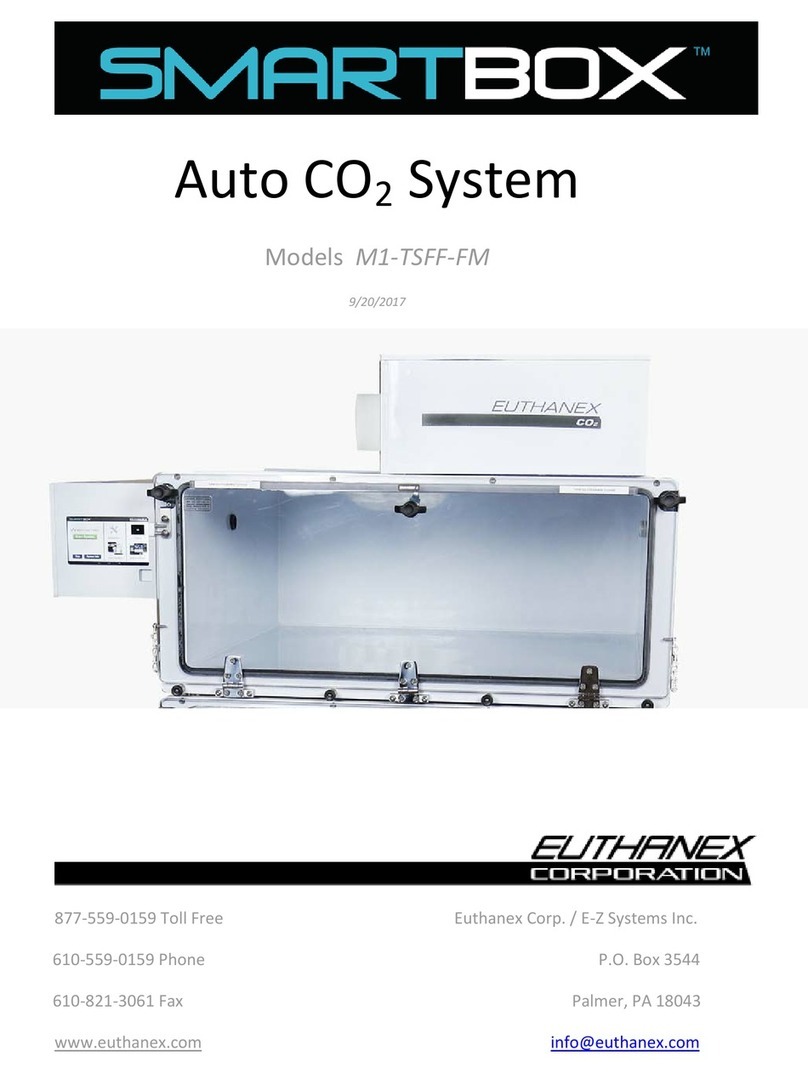
EUTHANEX
EUTHANEX SMARTBOX M1-TSFF-FM manual

Dorner
Dorner Aquaguard 7350 Series Installation, Maintenance, and Parts Manual
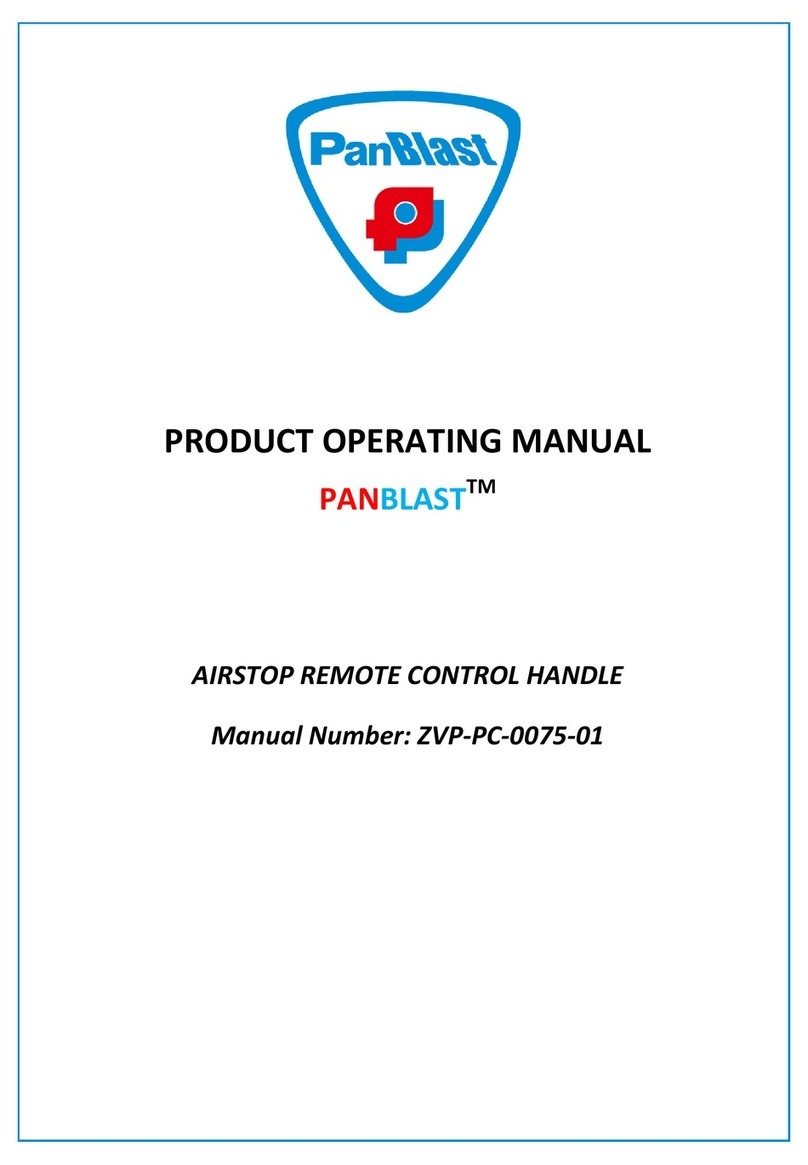
Panblast
Panblast ZVP-PC-0075-01 Product Operating Manual

READY
READY EPSON VT6L Startup guide
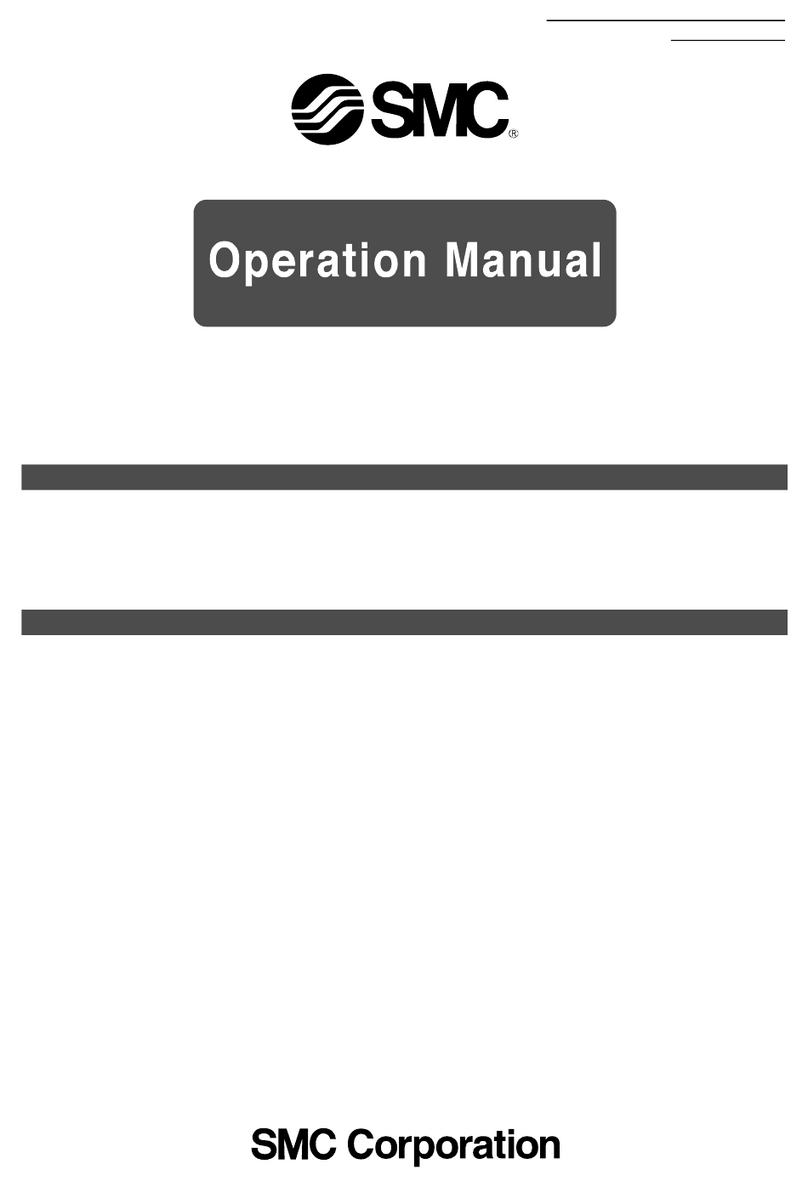
SMC Networks
SMC Networks IBG Series Operation manual

Quincy Compressor
Quincy Compressor QAF 6-1500 Instruction book
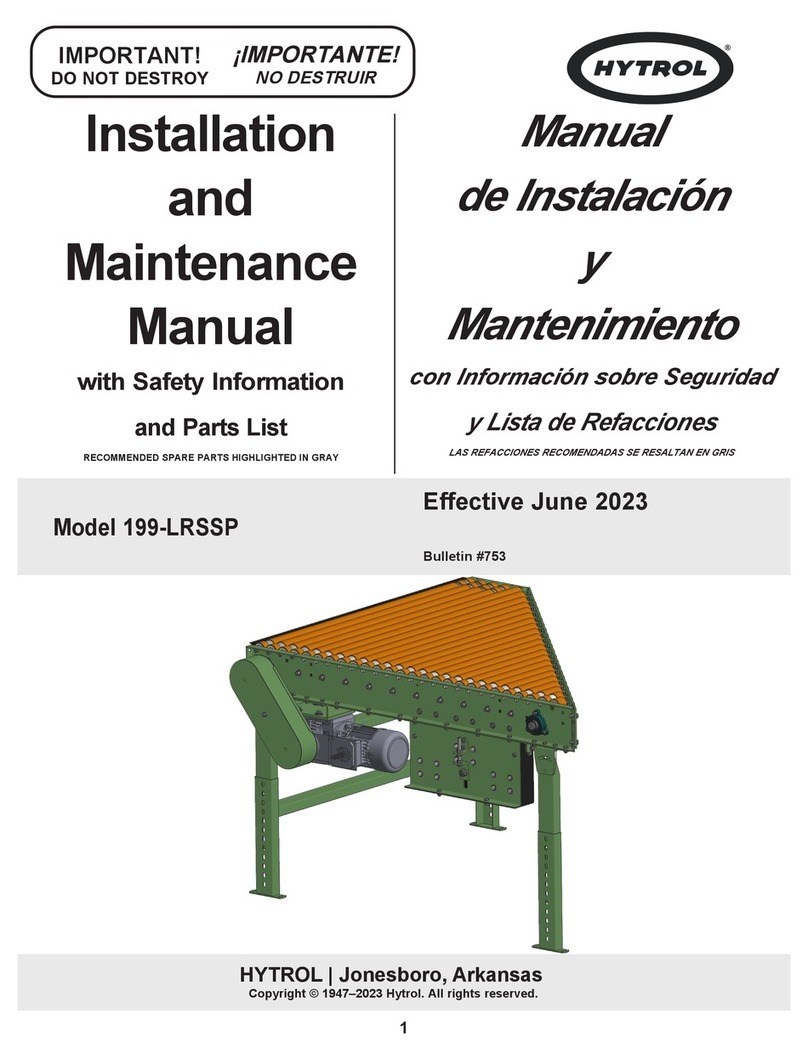
HYTROL
HYTROL 199-LRSSP Installation and maintenance manual
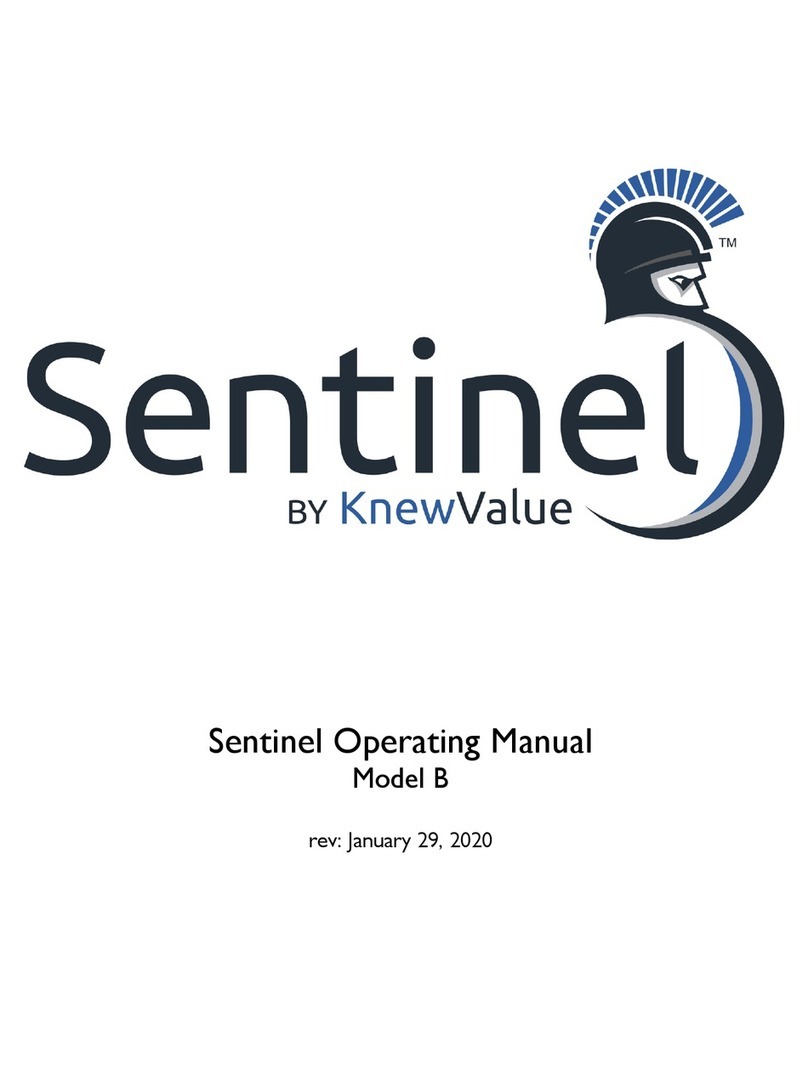
Knew Value
Knew Value Sentinel B operating manual
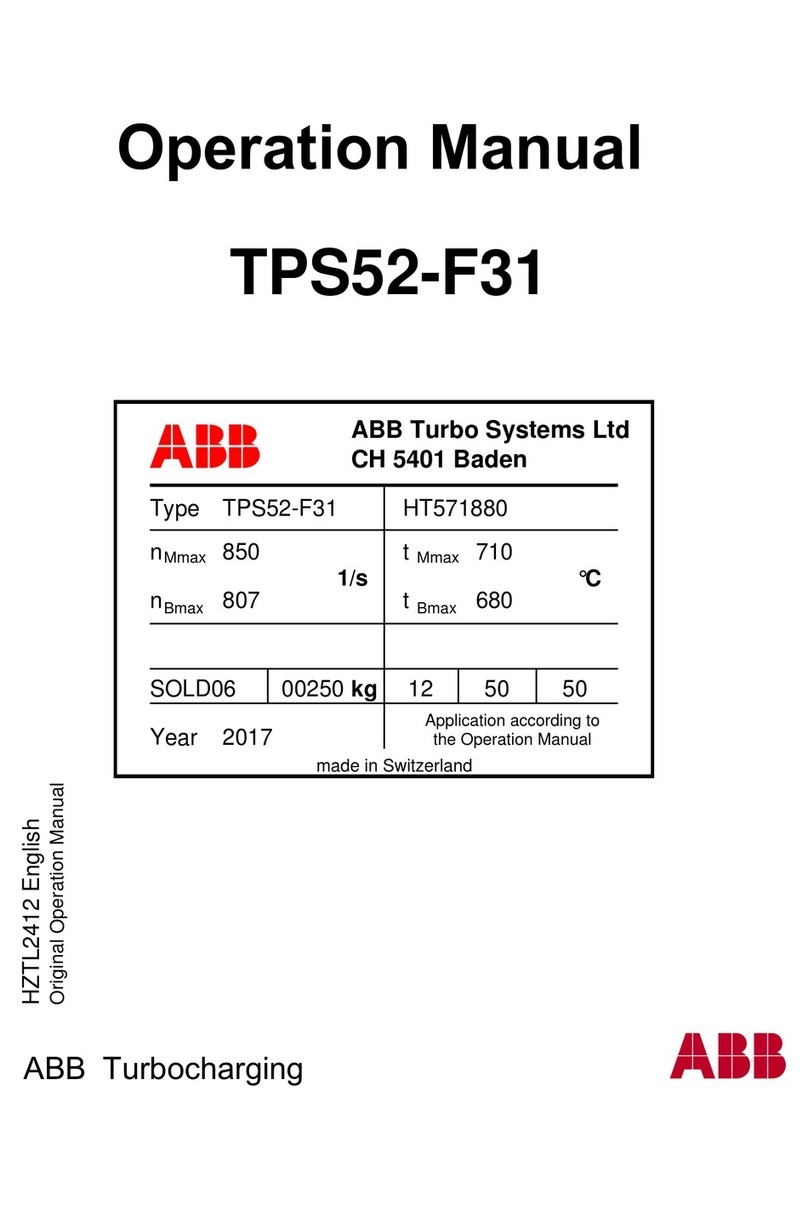
ABB
ABB HT571880 Operation manual
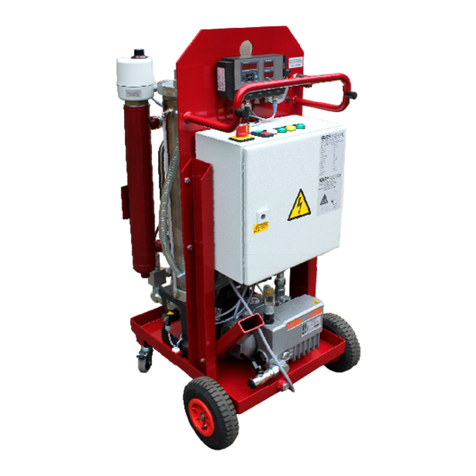
HYDAC FILTER SYSTEMS
HYDAC FILTER SYSTEMS FluidAqua Mobil FAM 5 Operating and maintenance instructions

IMC
IMC F79/060 Operating, and servicing instructions
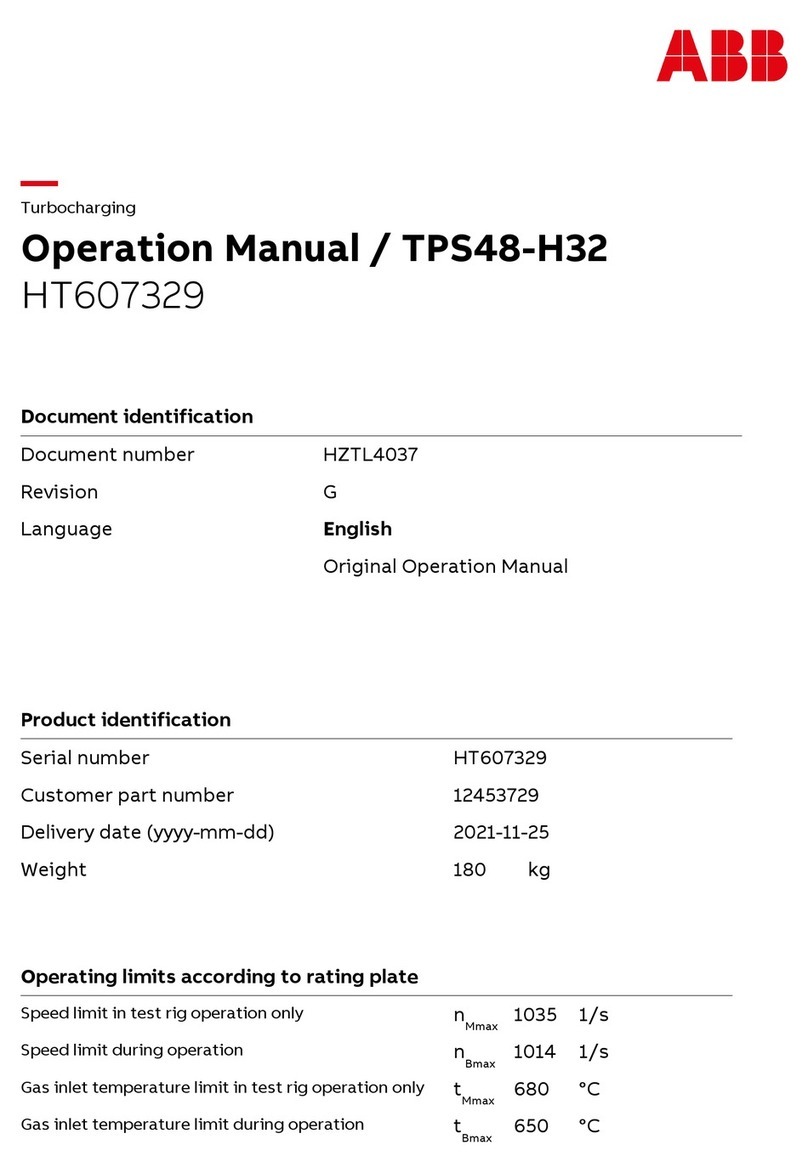
ABB
ABB HT607329 Operation manual
